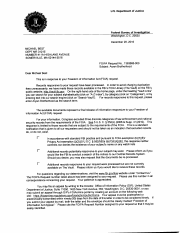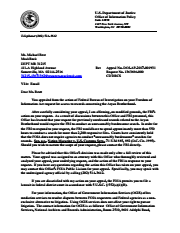Aryan Brotherhood
It is a clone of this request.
| Tracking # |
1363686-000, DOJ-AP-2017-001931 |
| Submitted | Dec. 23, 2016 |
MuckRock users can file, duplicate, track, and share public records requests like this one. Learn more.
Communications
From: Michael Best
To Whom It May Concern:
This is a request under the Freedom of Information Act. I hereby request the following records:
Records relating to or mentioning The Aryan Brotherhood, also known as The Brand, Alice Baker, AB or One-Two, which is the nation’s oldest major white supremacist prison gang and a national crime syndicate. Founded in 1964 by Irish bikers as a form of protection for white inmates in newly desegregated prisons, the AB is today the largest and deadliest prison gang in the United States, with an estimated 20,000 members inside prisons and on the streets.
Its motto is simple – “blood in, blood out.” AB chapters can be found in most major federal and state prisons in the country. As a crime syndicate, the AB participates in drug trafficking, male prostitution rings, gambling, and extortion inside prison walls. On the streets, the AB is involved in practically every kind of criminal enterprise, including murder-for-hire, armed robbery, gun running, methamphetamine manufacturing, heroin sales, counterfeiting and identity theft.
When officials began to desegregate state and federal prisons during the 1960s, black and white inmates were thrown up against each other in many cases for the first time, and violent conflicts resulted. The Aryan Brotherhood was formed at the San Quentin State Prison in California in 1964, organizing defensively against a violent black prison gang, the Black Guerilla Family, and becoming the first major white supremacist prison gang in the country in the process. Its original membership was largely Irish bikers who initially called themselves the Diamond Tooth Gang because members wore shards of glass in their teeth. But after merging with other white cliques in San Quentin, they renamed themselves the AB. Today, the gang operates both inside and outside prisons, and although it clearly has a white supremacist ideology, it is above all a criminal enterprise. Given the choice between making money and showing their racism, members virtually always go for the cash, meaning the gang has often worked with Latino and other gangs for profit.
Before joining the AB, potential recruits are required to “make their bones,” usually by attacking or murdering a rival gang member or assaulting a corrections officer (thus the “blood in” part of the gang’s motto; “blood out” indicates that once a person is part of the gang, the only way out is death). Inductees have been required to read Hitler’s Mein Kampf and, often, Sun Tzu’s The Art of War and Machiavelli’s The Prince. Many members practice Asatru, a neo-Pagan variant of pre-Christian Odinism that dates back to the Vikings and their Norse gods. Its adherents see themselves as ancient Viking warriors destined for Valhalla.
During the early 1970s, the California Department of Corrections noticed a startling increase in gang-related and racially motivated violence. Although the AB was not responsible for all of the reported deaths and assaults, it quickly earned a reputation for its “zero-tolerance” policy on “disrespect” from other inmates. At the same time, the AB signed on to a truce with another notorious racist prison gang, the Mexican Mafia (or “La Eme”), in that group’s battle with La Nuestra Familia, a Latino gang — early evidence that AB was more interested in profit than ideological purity.
By 1975, the Aryan Brotherhood had expanded into most California state prisons, where something of a race war was being waged. Within two years, moreover, as a number of high-ranking AB leaders were sent to federal prison, the group had seized the opportunity to begin to expand into the federal penitentiary system. As a result, the organization divided into the California AB and the federal system AB. “They’re like two related but different crime families,” said one former top AB leader. “They each have their [ruling] commission … but they’re allies.” At the same time, the group was growing. While there were fewer than 100 members in the late 1970s, hundreds more were recruited in following years, sometimes by swallowing whole racist skinhead gangs. Today, according to officials, there are a total of about 20,000 AB members, with large numbers present in both state and federal prisons.
In its early days, the Aryan Brotherhood employed a “one man, one vote” policy. This changed in the early 1980s after it became clear this policy was causing chaos within the organization. Both the federal and state prison gang factions implemented a hierarchical structure similar to that of the military. A 12-man council was sworn in with a majority vote. A three-man commission oversaw the council. Michael Thompson served on the California council, while Barry “Barron” Mills, T.D. Bingham and John Greschner (before he quit the group in 1999 and began talking about it to investigators and others) oversaw the federal operation. Tightening the command structure made the gang more powerful and more dangerous.
On Oct. 22, 1983, AB member Tommy Silverstein stabbed corrections officer Merle E. Clutts to death in the Marion, Ohio, federal penitentiary with the help of another inmate. Hours after Clutts was murdered, another AB member, Clayton Fountain, stabbed corrections officer Robert Hoffman and assaulted two other officers because he did not want Silverstein to have a higher body count than him. At the time, the Marion facility was believed to be the most secure federal prison in the country. In response to the incident, federal prisons across the country began to move known AB members to “supermax” units or prisons around the country. These inmates were typically held in solitary confinement 23 hours a day and their contact with other inmates and outsiders was severely restricted. But even this did not stop the AB from carrying out its criminal activities. Several court cases have made clear that AB leaders are able to organize major criminal activities, including ordering people’s deaths, despite their isolation. In many cases, officials say, they do this through their wives or girlfriends, and in some they have been able to use their lawyers. In others, they are known to use highly sophisticated written codes and invisible inks.
During the 1990s, the rapidly swelling AB increasingly favored organized criminal activity over promoting racism. That meant that the gang’s leaders recognized that drug trafficking in prison was a highly profitable enterprise and the gang began to sell drugs to African American and Latino inmates. According to imprisoned ex-AB “commissioner” John Greschner, who left the gang in 1999, race war ideology within the AB today is clearly secondary to its criminal activity. Greschner also has detailed how the gang instituted a sophisticated banking and collection system that included a 20% “tax” on the profits of any AB criminal enterprise on the streets. That money is laundered and controlled by the AB commissioners.
The AB’s criminal operations on the outside received a huge boost when Italian-American Mafia boss John Gotti was sentenced to life in prison without parole and transferred to the Marion facility in 1992. Gotti hired the AB to protect him, but went on to organize a business partnership between his associates and AB members on the outside. The move gave the AB unprecedented power on the streets, where the group had been operating in major cities since the 1980s, with an appointed leader in each city or, in the case of more sparsely populated areas, each region.
Gotti was not the gang’s first high-profile client. During the early 1970s, cult leader Charles Manson sought the AB’s protection. He was refused membership because he declined to kill other inmates because of their skin color. But the AB still used his coterie of female fans to smuggle drugs and weapons into San Quentin.
The AB is a notoriously deadly organization. Some years ago, authorities calculated that while the group’s members made up less than one tenth of 1% of the U.S. prison inmate population, they were responsible for 18% of all prison murders.
In recent years, authorities have been repeatedly frustrated by the way that imprisoned AB leaders have been able to organize and direct major criminal enterprises even from solitary confinement, where most are held. In 2002, they moved to indict 29 leaders of the federal AB organization, all of them held in various prisons around the country, for violations of federal Racketeer Influenced and Corrupt Organizations(RICO) Act. Twenty-one of the leaders were charged with death penalty offenses, even though many were already serving life terms, because prosecutors felt that was the only way they could stop their criminal activities. Among those charged with capital offenses were AB commissioners Mills and Bingham. But the tactic failed spectacularly when juries returned many convictions but no death penalties. The officials’ so-called “decapitation strike” had failed.
Members of the AB typically can be easily identified by their tattoos. Popular tattoos among AB members include a shamrock inscribed with the number 666, swastikas, the abbreviation A.B., and double lightning bolts, which stand for Hitler’s SS.
Please conduct a search of the Central Records System, including but not limited to the Electronic Surveillance (ELSUR) Indices, the Microphone Surveillance (MISUR) Indices, the Physical Surveillance (FISUR) Indices, and the Technical Surveillance (TESUR) Indices, for both main-file records and cross-reference records of both HQ and all field offices for all relevant names, agencies, organizations, companies and events including but not limited to those cited in the previous paragraphs and/or links. My request includes but is not limited to 137, 157, 176, 177, 183, 184, 188, and 214 files. If previously released records are available, then I request a rolling release consisting of those records while additional records are located and processed for release.
I am a member of the news media and request classification as such. I have previously written about the government and its activities for AND Magazine, MuckRock and Glomar Disclosure and have an open arrangement with each. My articles have been widely read, with some reaching over 100,000 readers. As such, as I have a reasonable expectation of publication and my editorial and writing skills are well established. In addition, I discuss and comment on the files online and make them available through the non-profit Internet Archive, disseminating them to a large audience. While my research is not limited to this, a great deal of it, including this, focuses on the activities and attitudes of the government itself. As such, it is not necessary for me to demonstrate the relevance of this particular subject in advance. Additionally, case law states that “proof of the ability to disseminate the released information to a broad cross-section of the public is not required.” Judicial Watch, Inc. v. Dep’t of Justice, 365 F.3d 1108, 1126 (D.C. Cir. 2004); see Carney v. U.S. Dep’t of Justice, 19 F.3d 807, 814-15 (2d Cir. 1994). Further, courts have held that "qualified because it also had “firm” plans to “publish a number of . . . ‘document sets’” concerning United States foreign and national security policy." Under this criteria, as well, I qualify as a member of the news media. Additionally, courts have held that the news media status "focuses on the nature of the requester, not its request. The provision requires that the request be “made by” a representative of the news media. Id. § 552(a)(4)(A)(ii)(II). A newspaper reporter, for example, is a representative of the news media regardless of how much interest there is in the story for which he or she is requesting information." As such, the details of the request itself are moot for the purposes of determining the appropriate fee category. As such, my primary purpose is to inform about government activities by reporting on it and making the raw data available and I therefore request that fees be waived.
The requested documents will be made available to the general public, and this request is not being made for commercial purposes.
In the event that there are fees, I would be grateful if you would inform me of the total charges in advance of fulfilling my request. I would prefer the request filled electronically, by e-mail attachment if available or CD-ROM if not.
Thank you in advance for your anticipated cooperation in this matter. I look forward to receiving your response to this request within 20 business days, as the statute requires.
Sincerely,
Michael Best
From: FOIPARequest
Good morning,
The FBI has received your Freedom of Information Act/Privacy (FOIPA) request and it will be forwarded to Initial Processing for review. Your request will be processed under the provisions of FOIPA and a response will be mailed to you at a later date.
Requests for fee waivers and expedited processing will be addressed once your request has been assigned an FOIPA request number. You will receive written notification of the FBI’s decision.
Information regarding the Freedom of Information Act/Privacy is available at http://www.fbi.gov/ or http://www.fbi.gov/foia/. If you require additional assistance please contact the Public Information Officer.
Thank you,
Holly Early
Government Information Specialist
Record/Information Dissemination Section (RIDS)
FBI-Records Management Division
170 Marcel Drive, Winchester, VA 22602-4843
PIO: (540) 868-4593
Direct: (540) 868-4854
Fax: (540) 868-4391/4997
E-mail: foiparequest@ic.fbi.gov<mailto:foiparequest@ic.fbi.gov>
Questions E-mail: foipaquestions@ic.fbi.gov<mailto:foipaquestions@ic.fbi.gov>
Do you have further questions about the FOI/PA process? Visit us at http://www.fbi.gov/foia
Please check the status of your request online at https://vault.fbi.gov/fdps-1/@@search-fdps. Status updates are performed on a weekly basis.
-

~WRD378
From: Federal Bureau of Investigation
A copy of documents responsive to the request.
From: Michael Best
I am appealing the integrity of the search as no search was performed. I specifically requested "a search of the Central Records System, including but not limited to the Electronic Surveillance (ELSUR) Indices, the Microphone Surveillance (MISUR) Indices, the Physical Surveillance (FISUR) Indices, and the Technical Surveillance (TESUR) Indices, for both main-file records and cross-reference records of both HQ and all field offices for all relevant names, agencies, organizations, companies and events including but not limited to those cited in the previous paragraphs and/or links as well as a cross-reference with the Southern Poverty Law Center to include any information provided by the SPLC. My request includes but is not limited to 137, 157, 176, 177, 183, 184, 188, 214 and 266 files. If previously released records are available, then I request a rolling release consisting of those records while additional records are located and processed for release." None of this was performed.
From: OIP-NoReply@usdoj.gov
01/27/2017 05:21 PM FOIA Request: DOJ-AP-2017-001931
From: OIP-NoReply@usdoj.gov
DOJ-AP-2017-001931 has been processed with the following final disposition: Affirmed on Appeal -- Records not reasonably described.
Files
pages


